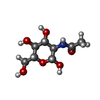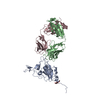+Search query
-Structure paper
| Title | Dissecting human monoclonal antibody responses from mRNA- and protein-based XBB.1.5 COVID-19 monovalent vaccines. |
|---|---|
| Journal, issue, pages | bioRxiv, Year 2024 |
| Publish date | Jul 16, 2024 |
 Authors Authors | Raianna F Fantin / Jordan J Clark / Hallie Cohn / Deepika Jaiswal / Bailey Bozarth / Alesandro Civljak / Vishal Rao / Igor Lobo / Jessica R Nardulli / Komal Srivastava / Jeremy Yong / Robert Andreata-Santos / Kaitlyn Bushfield / Edward S Lee / Gagandeep Singh / / Steven H Kleinstein / Florian Krammer / Viviana Simon / Goran Bajic / Camila H Coelho /    |
| PubMed Abstract | The emergence of highly contagious and immune-evasive severe acute respiratory syndrome coronavirus 2 (SARS-CoV-2) variants has required reformulation of coronavirus disease 2019 (COVID-19) vaccines ...The emergence of highly contagious and immune-evasive severe acute respiratory syndrome coronavirus 2 (SARS-CoV-2) variants has required reformulation of coronavirus disease 2019 (COVID-19) vaccines to target those new variants specifically. While previous infections and booster vaccinations can enhance variant neutralization, it is unclear whether the monovalent version, administered using either mRNA or protein-based vaccine platforms, can elicit B-cell responses specific for Omicron XBB.1.5 variants. Here, we dissected the genetic antibody repertoire of 603 individual plasmablasts derived from five individuals who received a monovalent XBB.1.5 vaccination either with mRNA (Moderna or Pfizer/BioNtech) or adjuvanted protein (Novavax). From these sequences, we expressed 100 human monoclonal antibodies and determined binding, affinity and protective potential against several SARS-CoV-2 variants, including JN.1. We then select two vaccine-induced XBB.1.5 mAbs, M2 and M39. M2 mAb was a , antibody, i.e., specific for XBB.1.5 but not ancestral SARS-CoV-2. M39 bound and neutralized both XBB.1.5 and JN.1 strains. Our high-resolution cryo-electron microscopy (EM) structures of M2 and M39 in complex with the XBB.1.5 spike glycoprotein defined the epitopes engaged and revealed the molecular determinants for the mAbs' specificity. These data show, at the molecular level, that monovalent, variant-specific vaccines can elicit functional antibodies, and shed light on potential functional and genetic differences of mAbs induced by vaccinations with different vaccine platforms.\. |
 External links External links |  bioRxiv / bioRxiv /  PubMed:39071292 / PubMed:39071292 /  PubMed Central PubMed Central |
| Methods | EM (single particle) |
| Resolution | 2.37 - 2.65 Å |
| Structure data | EMDB-45443, PDB-9cci: EMDB-45444, PDB-9ccj: |
| Chemicals |  ChemComp-NAG: |
| Source |
|
 Keywords Keywords | VIRAL PROTEIN/IMMUNE SYSTEM / SARS-CoV-2 / Antibody / RBD / Immune SYSTEM / VIRUS LIKE PARTICLE / VIRAL PROTEIN-IMMUNE SYSTEM complex / NTD |
 Movie
Movie Controller
Controller Structure viewers
Structure viewers About Yorodumi Papers
About Yorodumi Papers







 homo sapiens (human)
homo sapiens (human)
